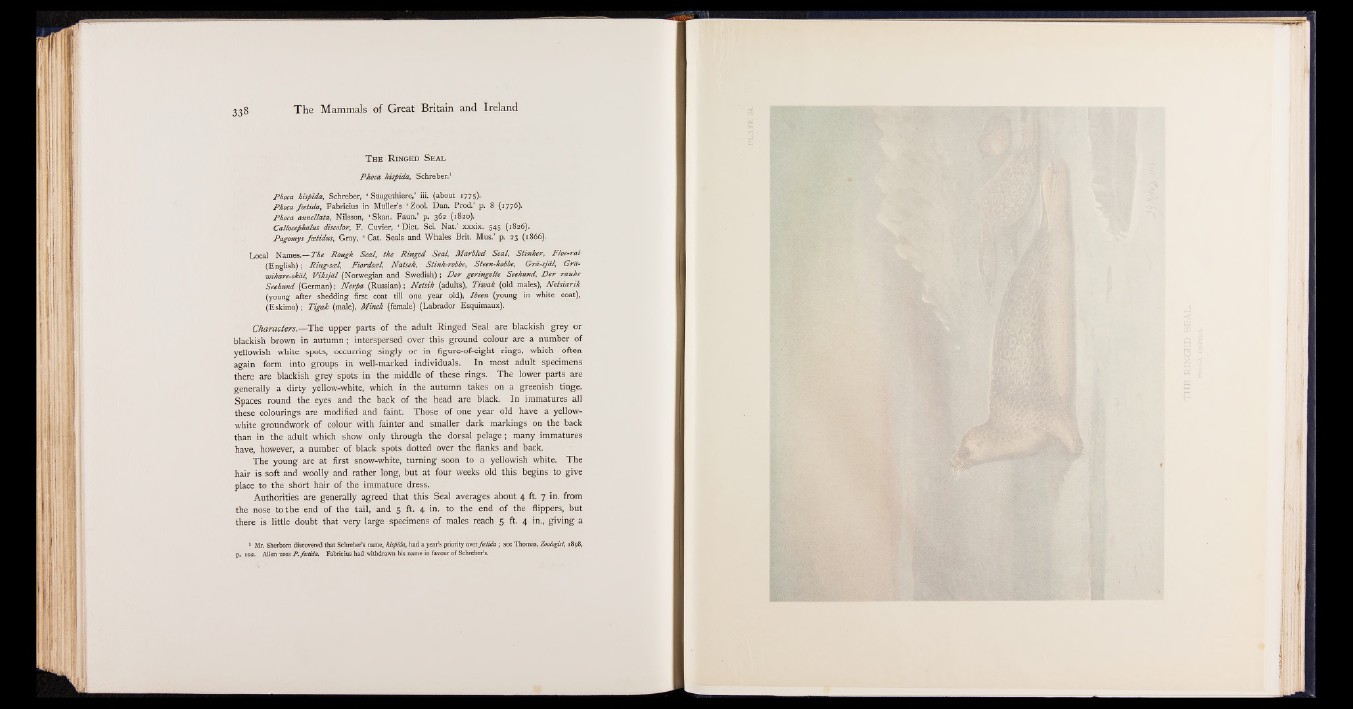
33» The Mammals of Great Britain and Ireland
T h e R in g e d S e a l
Phoca hispida, Schreber.1
Phoca hispida, Schreber, ‘ Saugethiere,’ iii. (about 1775).
Phoca fcetida, Fabricius in Muller’s ‘ Zool. Dan. Prod.’ p. 8 (1776).
Phoca annellata, Nilsson, ‘ Skan. Faun.’ p. 362 (1820).
Callocephalus discolor, F. Cuvier, * Diet. Sci. Nat.’ xxxix. 545 (1826).
Pagomys feetidus, Gray, ‘ Cat. Seals and Whales Brit. Mus.’ p. 23 (1866).
Local Names.— The Rough Seal, the Ringed Seal, Marbled Seal, Stinker, Floe-rat
(English); Ring-sal, Fiordsal, Natsek, Stink-robbe, Steen-kobbe, Gra-sjdl, Gra-
wikare-skal, V iksjal (Norwegian and Swedish); D er geringelte Seehund, D er rauhe
Seehund (German); Nerpa (Russian) ; N etsik (adults), Tiwak (old males), Netsiarik
(young after shedding first coat till one year old), Ibeen (young in white coat),
(Eskimo); Tigak (male), Minek (female) (Labrador Esquimaux).
Characters— The upper parts of the adult Ringed Seal are blackish grey or
blackish brown in autumn; interspersed over this ground colour are a number of
yellowish white spots, occurring singly or in figure-of-eight rings, which often
again form into groups in well-marked individuals. In most adult specimens
there are blackish grey spots in the middle of these rings. The lower parts are
generally a dirty yellow-white, which in the autumn takes on a greenish tinge.
Spaces round the eyes and the back of the head are black. In immatures all
these colourings are modified and faint. Those of one year old have a yellow-
white groundwork of colour with fainter and smaller dark markings on the back
than in the adult which show only through the dorsal pelage; many immatures
have, however, a number of black spots dotted over the flanks and back.
The young are at first snow-white, turning soon to a yellowish white. The
hair is soft and woolly and rather long, but at four weeks old this begins to give
place to the short hair of the immature dress.
Authorities are generally agreed that this Seal averages about 4 ft. 7 in. from
the nose to the end of the tail, and 5 ft. 4 in. to the end of the flippers, but
there is little doubt that very large specimens of males reach 5 ft. 4 in., giving a
1 Mr. Sherborn discovered that Schreber’s name, hispida, had a year’s priority over fcetida ; see Thomas, Zoologist, 1898,
p. 10a. Allen uses P . fcetida. Fabricius had withdrawn his name in favour of Schreber’s.